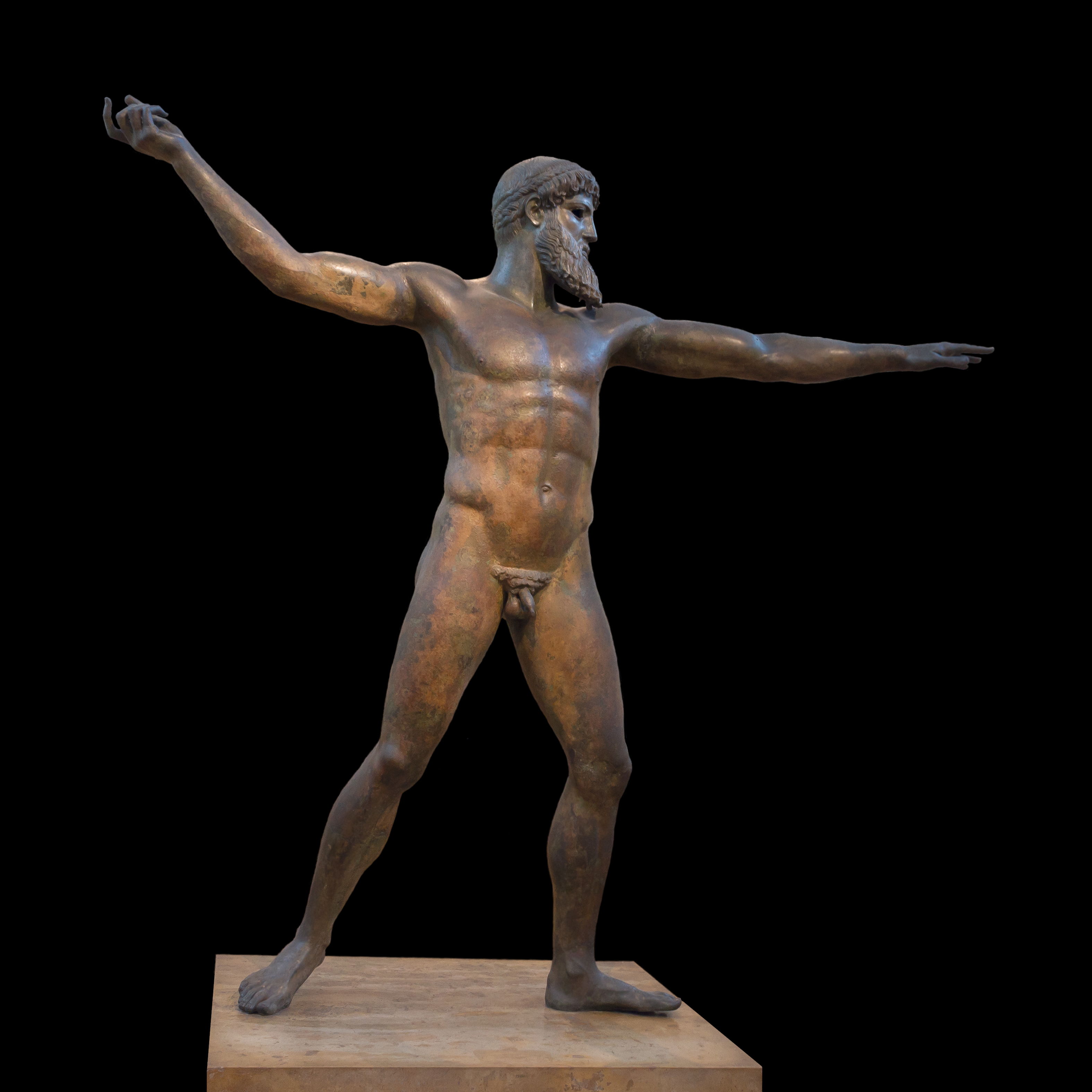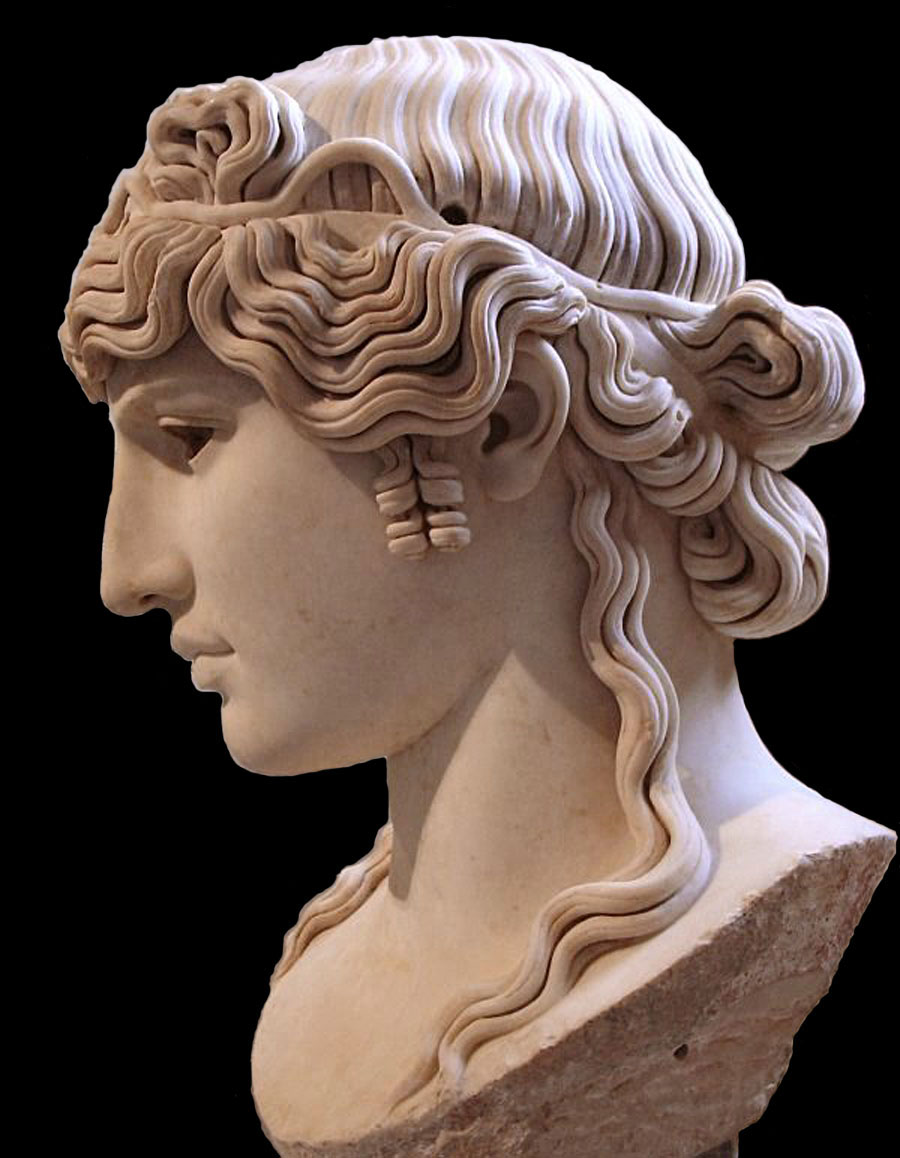|
Greek Statue
The sculpture of ancient Greece is the main surviving type of fine ancient Greek art as, with the exception of painted ancient Greek pottery, almost no ancient Greek painting survives. Modern scholarship identifies three major stages in monumental sculpture in bronze and stone: the Archaic (from about 650 to 480 BC), Classical (480–323) and Hellenistic. At all periods there were great numbers of Greek terracotta figurines and small sculptures in metal and other materials. The Greeks decided very early on that the human form was the most important subject for artistic endeavour. Seeing their gods as having human form, there was little distinction between the sacred and the secular in art—the human body was both secular and sacred. A male nude of Apollo or Heracles had only slight differences in treatment to one of that year's Olympic boxing champion. The statue, originally single but by the Hellenistic period often in groups was the dominant form, though reliefs, often s ... [...More Info...] [...Related Items...] OR: [Wikipedia] [Google] [Baidu] |
Cavalcade South Frieze Parthenon BM
A cavalcade is a procession or parade on horseback, or a mass trail ride by a company of riders. The focus of a cavalcade is participation rather than display. Often, the participants do not wear costumes or ride in formation. Often, a cavalcade re-enacts an important historical event and follows a long-distance trail. A cavalcade may also be a pilgrimage. Many cavalcades involve ceremonial entries into and departures from towns and villages along the way. A small version of such a ceremonial entry is the "grand entry" that is traditional in many rodeos. Long-distance cavalcades may acquire more riders who join from populated places along its route. The term ''cavalcade'' comes from the classical Latin word ''caballus'', used to describe a strong work horse. This developed into the word ''caballicare,'' "to ride horseback," which in Italian became ''cavalcare.'' In Spanish the term for cavalcade is ''cabalgata.'' United States In New Mexico, Philmont Scout Ranch in ... [...More Info...] [...Related Items...] OR: [Wikipedia] [Google] [Baidu] |
Marble
Marble is a metamorphic rock composed of recrystallized carbonate minerals, most commonly calcite or Dolomite (mineral), dolomite. Marble is typically not Foliation (geology), foliated (layered), although there are exceptions. In geology, the term ''marble'' refers to metamorphosed limestone, but its use in stonemasonry more broadly encompasses unmetamorphosed limestone. Marble is commonly used for Marble sculpture, sculpture and as a building material. Etymology The word "marble" derives from the Ancient Greek (), from (), "crystalline rock, shining stone", perhaps from the verb (), "to flash, sparkle, gleam"; Robert S. P. Beekes, R. S. P. Beekes has suggested that a "Pre-Greek origin is probable". This Stem (linguistics), stem is also the ancestor of the English language, English word "marmoreal," meaning "marble-like." While the English term "marble" resembles the French language, French , most other European languages (with words like "marmoreal") more closely resemb ... [...More Info...] [...Related Items...] OR: [Wikipedia] [Google] [Baidu] |
Stucco
Stucco or render is a construction material made of aggregates, a binder, and water. Stucco is applied wet and hardens to a very dense solid. It is used as a decorative coating for walls and ceilings, exterior walls, and as a sculptural and artistic material in architecture. Stucco can be applied on construction materials such as metal, expanded metal lath, concrete, cinder block, or clay brick and adobe for decorative and structural purposes. In English, "stucco" sometimes refers to a coating for the outside of a building and "plaster" to a coating for interiors; as described below, however, the materials themselves often have little to no differences. Other European languages, notably Italian, do not have the same distinction; ''stucco'' means ''plaster'' in Italian and serves for both. Composition The basic composition of stucco is cement, water, and sand. The difference in nomenclature between stucco, plaster, and mortar is based more on use than composition. Until ... [...More Info...] [...Related Items...] OR: [Wikipedia] [Google] [Baidu] |
Architectural Sculpture
Architectural sculpture is the use of sculptural techniques by an architect and/or sculptor in the design of a building, bridge, mausoleum or other such project. The sculpture is usually integrated with the structure, but freestanding works that are part of the original design are also considered to be architectural sculpture. The concept overlaps with, or is a subset of, monumental sculpture. It has also been defined as "an integral part of a building or sculpture created especially to decorate or embellish an architectural structure." Architectural sculpture has been employed by builders throughout history, and in virtually every continent on earth save pre-colonial Australia. Egyptian Modern understanding of ancient Egyptian architecture is based mainly on the religious monuments that have survived since antiquity, which are carved stone with post and lintel construction. These religious monuments dedicated to the gods or pharaohs were designed with a great deal of architec ... [...More Info...] [...Related Items...] OR: [Wikipedia] [Google] [Baidu] |
Limestone
Limestone ( calcium carbonate ) is a type of carbonate sedimentary rock which is the main source of the material lime. It is composed mostly of the minerals calcite and aragonite, which are different crystal forms of . Limestone forms when these minerals precipitate out of water containing dissolved calcium. This can take place through both biological and nonbiological processes, though biological processes, such as the accumulation of corals and shells in the sea, have likely been more important for the last 540 million years. Limestone often contains fossils which provide scientists with information on ancient environments and on the evolution of life. About 20% to 25% of sedimentary rock is carbonate rock, and most of this is limestone. The remaining carbonate rock is mostly dolomite, a closely related rock, which contains a high percentage of the mineral dolomite, . ''Magnesian limestone'' is an obsolete and poorly-defined term used variously for dolomite, for limes ... [...More Info...] [...Related Items...] OR: [Wikipedia] [Google] [Baidu] |
Riace Bronzes
The ''Riace bronzes'' (Italian: ''Bronzi di Riace'', ), also called the Riace Warriors, are two full-size Greek bronzes of naked bearded warriors, cast about 460–450 BC that were found in the sea in 1972 near Riace, Calabria, in southern Italy. The bronzes are now in the Museo Nazionale della Magna Grecia in the nearby city of Reggio Calabria. They are two of the few surviving full-size ancient Greek bronzes (which were usually melted down in later times), and as such demonstrate the superb technical craftsmanship and exquisite artistic features that were achieved at this time. The bronzes are now on display inside a microclimate room on top of an anti-seismic platform faced in Carrara marble. Along with the bronzes, the room also contains two head sculptures: Testa del Filosofo anTesta di Basilea which are also from the 5th century BC. Although the bronzes were discovered in 1972, they did not emerge from conservation until 1981. Their public display in Florence and Rome ... [...More Info...] [...Related Items...] OR: [Wikipedia] [Google] [Baidu] |
Artemision Bronze
The Artemision Bronze (often called the God from the Sea) is an ancient Greek sculpture that was recovered from the sea off Cape Artemision, in northern Euboea, Greece. According to most scholars, the bronze represents Zeus, the thunder-god and king of gods, though it has also been suggested it might represent Poseidon. The statue is slightly over lifesize at 209 cm,Susan. (1982) ''The Art of Greece and Rome''. Cambridge: Cambridge University Press, p. 15. ; Dafas, K. A., 2019. ''Greek Large-Scale Bronze Statuary: The Late Archaic and Classical Periods'', Institute of Classical Studies, School of Advanced Study, University of London, Bulletin of the Institute of Classical Studies, Monograph, BICS Supplement 138 (London), pp. 36–50, pls 31–40. and would have held either a thunderbolt, if Zeus, or a trident if Poseidon. The empty eye-sockets were originally inset, probably with bone, as well as the eyebrows (with silver), the lips, and the nipples (with copper). The sculpto ... [...More Info...] [...Related Items...] OR: [Wikipedia] [Google] [Baidu] |
Trawling
Trawling is a method of fishing that involves pulling a fishing net through the water behind one or more boats. The net used for trawling is called a trawl. This principle requires netting bags which are towed through water to catch different species of fishes or sometimes targeted species. Trawls are often called towed gear or dragged gear. The boats that are used for trawling are called trawlers or draggers. Trawlers vary in size from small open boats with as little as 30 hp (22 kW) engines to large factory trawlers with over 10,000 hp (7.5 MW). Trawling can be carried out by one trawler or by two trawlers fishing cooperatively (pair trawling). Trawling can be contrasted with trolling. While trawling involves a net and is typically done for commercial usage, trolling instead involves a reed, rod and a bait or a lure and is typically done for recreational purposes. Trawling is also commonly used as a scientific sampling, or survey, method. Bottom vs. midwater trawling ... [...More Info...] [...Related Items...] OR: [Wikipedia] [Google] [Baidu] |
Marine Archaeology
Maritime archaeology (also known as marine archaeology) is a discipline within archaeology as a whole that specifically studies human interaction with the sea, lakes and rivers through the study of associated physical remains, be they vessels, shore-side facilities, port-related structures, cargoes, human remains and submerged landscapes. A specialty within maritime archaeology is nautical archaeology, which studies ship construction and use. As with archaeology as a whole, maritime archaeology can be practised within the historical, industrial, or prehistoric periods. An associated discipline, and again one that lies within archaeology itself, is underwater archaeology, which studies the past through any submerged remains be they of maritime interest or not. An example from the prehistoric era would be the remains of submerged settlements or deposits now lying under water despite having been dry land when sea levels were lower. The study of submerged aircraft lost in lakes, r ... [...More Info...] [...Related Items...] OR: [Wikipedia] [Google] [Baidu] |
Acrolith
An acrolith is a composite sculpture made of stone together with other materials such as wood or inferior stone such as limestone, as in the case of a figure whose clothed parts are made of wood, while the exposed flesh parts such as head, hands, and feet are made of marble. The wood was covered either by drapery or by gilding. This type of statuary was common and widespread in Classical antiquity. Greek etymology: ''acros'' and ''lithos'', English translation: "extremity" and "stone". Similarly, chryselephantine sculpture used ivory instead of marble, and often gold on parts of the body and ornaments. Acroliths are frequently mentioned by Pausanias (2nd century AD), the best known example being the Athene Areia ("Warlike Athena") of the Plataeans. It was common practice in antiquity to drape statues with clothing. "If such statues were draped, only the visible areas of the body, the head, feet and hands needed to be rendered in an attractive material, namely stone. If the st ... [...More Info...] [...Related Items...] OR: [Wikipedia] [Google] [Baidu] |
Athena Workshop Sculptor Staatliche Antikensammlungen 2650
Athena or Athene, often given the epithet Pallas, is an ancient Greek goddess associated with wisdom, warfare, and handicraft who was later syncretized with the Roman goddess Minerva. Athena was regarded as the patron and protectress of various cities across Greece, particularly the city of Athens, from which she most likely received her name. The Parthenon on the Acropolis of Athens is dedicated to her. Her major symbols include owls, olive trees, snakes, and the Gorgoneion. In art, she is generally depicted wearing a helmet and holding a spear. From her origin as an Aegean palace goddess, Athena was closely associated with the city. She was known as ''Polias'' and ''Poliouchos'' (both derived from ''polis'', meaning "city-state"), and her temples were usually located atop the fortified acropolis in the central part of the city. The Parthenon on the Athenian Acropolis is dedicated to her, along with numerous other temples and monuments. As the patron of craft and weaving, ... [...More Info...] [...Related Items...] OR: [Wikipedia] [Google] [Baidu] |
Parian Marble
Parian marble is a fine-grained semi translucent pure-white and entirely flawless marble quarried during the classical era on the Greek island of Paros in the Aegean Sea. It was highly prized by ancient Greeks for making sculptures. Some of the greatest masterpieces of ancient Greek sculpture were carved from Parian marble, including the ''Medici Venus'', the ''Venus de Milo'', and the ''Winged Victory of Samothrace''. The original quarries, which were used from the 6th century BC onwards, can still be seen on the north side of the island on the slopes of its central peak. The Parian's main rival in antiquity was Pentelic marble, which is also flawless white, albeit with a uniform, faint yellow tint that makes it shine with a golden hue under sunlight. It is today mined mostly on the neighbour island of Paros, Naxos, in the mountains near the village of Kinidaros. Parian ware is an artificial substitute for marble, originally a brand name for a variety of unglazed biscuit porc ... [...More Info...] [...Related Items...] OR: [Wikipedia] [Google] [Baidu] |











